Tags
Académie des sciences, air flow, Antoine Lavoisier, architect, Architecte de la ville de Paris, beheading, Bernard Poyet, chapel, Claude Philibert Coquéau, Eiffel Tower, French, guillotine, hospital, Hôtel-Dieu, Ministry of the Interior, Montecello, Notre Dame, Paris, pharmacy, Revolutionary Tribunal of Paris, Seine, Thermidor, Thomas Jefferson, urban design
Memoire sur la necessite de transfer et…
Claude Philibert Coquéau (1755-1794)
Paris: s.n., 1785
Sole edition
This is architect Bernard Poyet’s proposal for the Paris public hospital (Hôtel-Dieu), then one of the busiest and least sanitary hospitals in the world (and that is saying something!). The hospital housed three to seven thousand patients a day in twelve hundred beds. Erected on the banks of the Seine by Notre Dame between 1200 and 1250, it was enlarged during the subsequent centuries in a haphazard manner. The original buildings suffered a series of fires between 1737 and 1772, leaving a large part of the complex destroyed. To replace the existing facility, Poyet (1742-1824), Architecte de la ville de Paris, conceived a circular building along the river, adjacent to where the Eiffel Tower stands today.
The wheel-shaped building would accommodate five thousand beds and allow for expansion. The ground floor would house the pharmacy, kitchens, administrative offices and other services. The upper floors were devoted to patient care, with sixteen rooms each accommodating eighty-four beds. The ring surrounded a circular courtyard with a freestanding chapel at its center. The plan included specialized outbuildings for birthing and highly contagious patients, large adjoining green spaces, an animal slaughter house. There were several critiques of Poyet’s plan, including that of the Académie des sciences, which objected to the building’s circular form. “The wards are too close as they approach the center…” The Académie was particularly concerned with “infected air” and the best means in which to vitiate it. Air flow was a huge concern. Wind flow was Poyet’s answer to this concern. He believed that the flow of water along the River Seine encouraged the flow of air.
Poyet sited his hospital on an island, maximizing water, and therefore air, flow. The long, spoked wards opened at the short ends, allowing winds to flow the length of the wards and into the open central courtyard.
The royal commission chose an alternative plan, which was not realized until the 19th-century. There is evidence, however, that Thomas Jefferson approved of Poyet’s hospital design and drew from it for his Montecello. Jefferson was in Paris at the time of the publication of this pamphlet.
Poyet continued to be involved in urban design schemes in Paris in the 1790s and in to the early 18th century. The author of this pamphlet, outlining Poyet’s plan, Claude Philibert Coquéau, was also a French architect. He joined the Ministry of the Interior in 1792.
Guilty by association, Coquéau was sentenced to death by the Revolutionary Tribunal of Paris and guillotined on 8 Thermidor II.
Three folding etched plates illustrate Poyet’s design.
Rare Books copy in self-wrappers, stabbed as issued.
RELEVÉ DES PRINCIPALES ERREURS CONTENUES DANS LE…
Paris: s.n., 1785
Sole edition
This anonymous critique of Poyet’s ideas for a new hospital downplays general concerns for overcrowding in the current hospital, argues that Poyet’s estimation of twenty-five percent mortality rate is high, suggests the quality of service is just fine, and objects to numerous aspects of Poyet’s design, including the number of steps to the second floor. Our copy is distinguished by manuscript annotations on several pages by the chemist Antoine Lavoisier, who points out the discrepancies between the Relevé’s contentions and the facts and clearly sympathizes with Poyet’s point of view. As a dedicated civil servant, Lavoisier was very interested in the reconstruction of the hospital, especially after the fire of 1772.
Lavoisier’s advocacy for renovation continued until he was beheaded in May 1794.

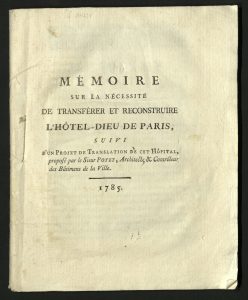
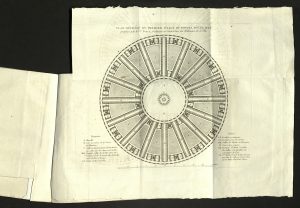
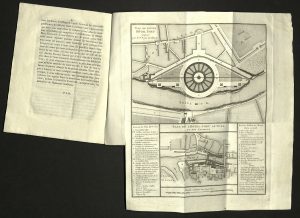
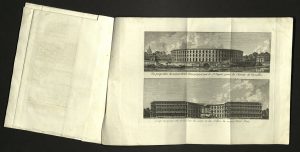
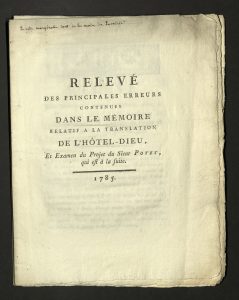
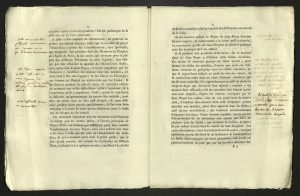
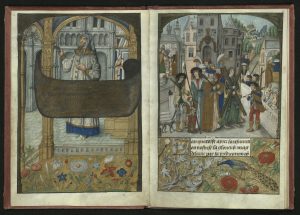

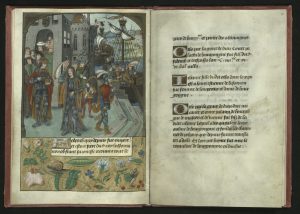
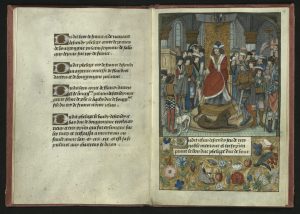
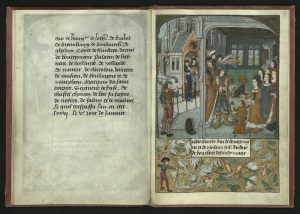
You must be logged in to post a comment.